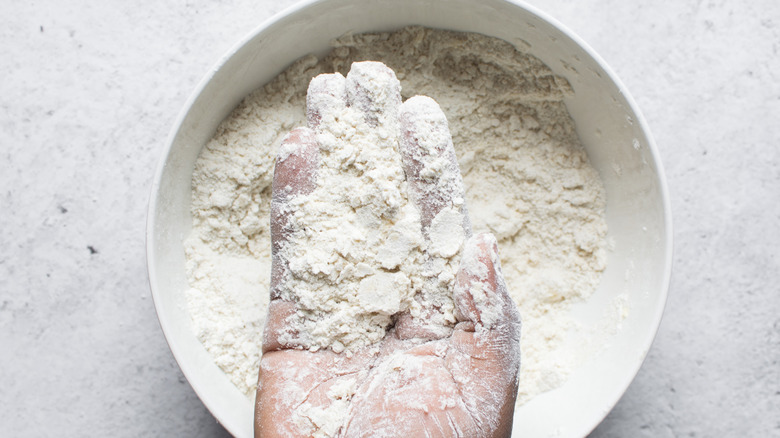How To Cut In Butter Like A Pro-Baker
Sometimes you can come across a step in a baking recipe that can be a real head-scratcher. Take "cutting in the butter," for example. This is a crucial step for making light, fluffy biscuits or scones (which are not the same thing) and flaky pie crusts, but if you're not yet initiated into baking terms, it's hard to know what exactly the recipe writer had in mind.
Cutting in butter is a technique for mixing cold butter (or any other fat) into dry ingredients like flour to make sticky crumbs. When the dough for the recipe is totally combined, those little pockets of butter will melt, and the water inside will turn to steam, creating a light, fluffy texture. The goal is to combine the two things without melting the butter, which takes a little bit of practice — and perhaps a few specialty kitchen tools.
To get to the bottom of how pro-bakers cut butter into their recipes, we reached out to Casey Nunes, the education content coordinator and instructor at the Wilton Sweet Studio, the famed cake decorating and confectionary art school associated with the Wilton cake decorating supplies. Nunes not only gave us her tried-and-true technique for cutting in butter, she also talked about the best kitchen tools to use for it, along with the most common mistakes people make when performing this crucial baking step.
The basics of cutting in butter
Cutting butter into flour is a simple technique, according to Casey Nunes. "You'll want to cut in cold butter and combine it with the flour quickly to make sure it stays cold," she said. "Start by cubing cold butter then adding it into your flour and blending until you get crumbs that are small balls."
While you may see an old-school baker cutting in butter using their bare hands, that's not the best way to keep the butter from warming up since your body heat will transfer to the butter and make it soft. "Using an old-fashioned pastry cutter (sometimes called a pastry blender) is the best way to create those gorgeous, coarse crumbs," said Nunes.
Once you have the butter in contact with the flour, it's a matter of combining the two to make those coarse crumbs while keeping the butter cold. The end result should look a bit like wet sand. Chop your tool through the cubes of fat until you get bits of flour-coated butter that are roughly the size of small green peas. From there, the recipe usually calls for adding liquid to bring the dough together, like water for pie crust or buttermilk for biscuits.
Other tools to use for cutting in butter
While the term "cutting in butter" might sound like you need to grab a butter knife, cutting in butter doesn't mean cutting just one piece of it like you would for a slice of toast. Think of it as cutting a ton of tiny pieces of butter, which is a lot easier to achieve if you have the right tool. If you don't have the aforementioned pastry cutter, Casey Nunes also suggests using a food processor, which can chop cold butter into little bits with just a few pulses as long as you don't overblend the ingredients. Her favorite technique, however, uses a tool that's more common on pizza night. "My preferred method for cutting in butter is to freeze the butter, then grate it on a cheese grater, making sure to keep my dry ingredients cold in the fridge or freezer," she said.
Nunes said you can also use two knives or forks for this task. Whichever tools you choose, though, your goal is the same. She said, "You want to make sure your butter has small pieces intact before baking so they can melt as they bake and create pockets of separation in your dough."
Temperature control and troubleshooting
If you like to bake, you know it's not so easy to keep things cold in a hot kitchen once the oven is on. Casey Nunes emphasized, however, that keeping the butter cold is actually the most important part of the process. "The most common mistake (depending on recipe) is having your butter at the wrong temperature — you don't want your butter to get too soft," she said. "You'll want to cut in cold butter and combine it with the flour quickly to make sure it stays cold. ... I usually cut up my butter and place it in the freezer and put ice cubes in the water."
If the butter gets warm, instead of pockets of fat in the dough, you'll create something more like a roux. This won't lead to flaky layers, so start with very small pieces of butter — at least ½-inch cubes. The bigger the chunks, the more you'll have to exert pressure on the butter to cut it into the flour, which creates heat. If you find at any point of the process that the butter is getting too soft, practice some patience, stop what you're doing, and put the whole bowl of flour and butter into the refrigerator for 10 to 15 minutes. This will cool everything down and firm up the butter so you can start the process again.



